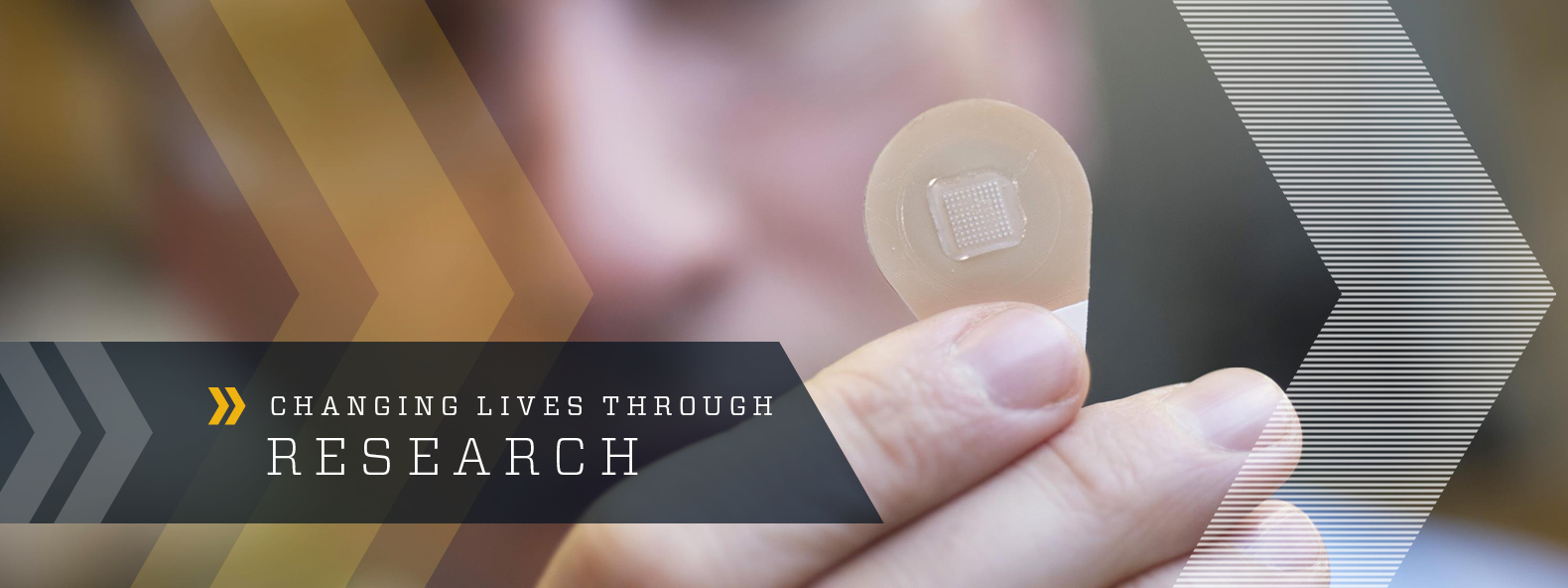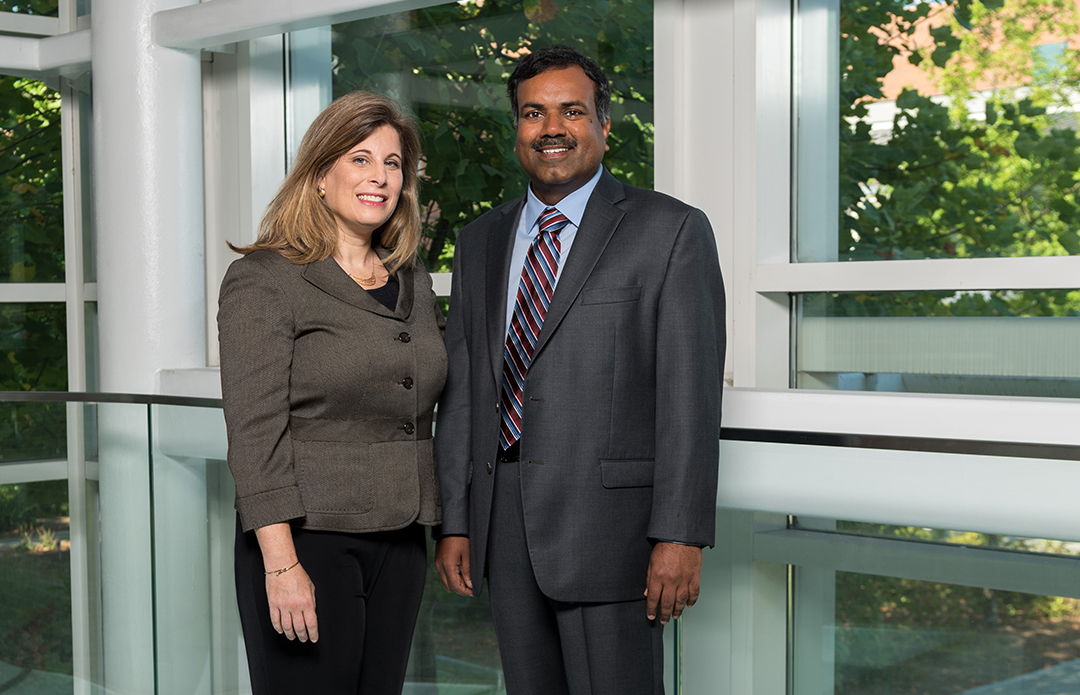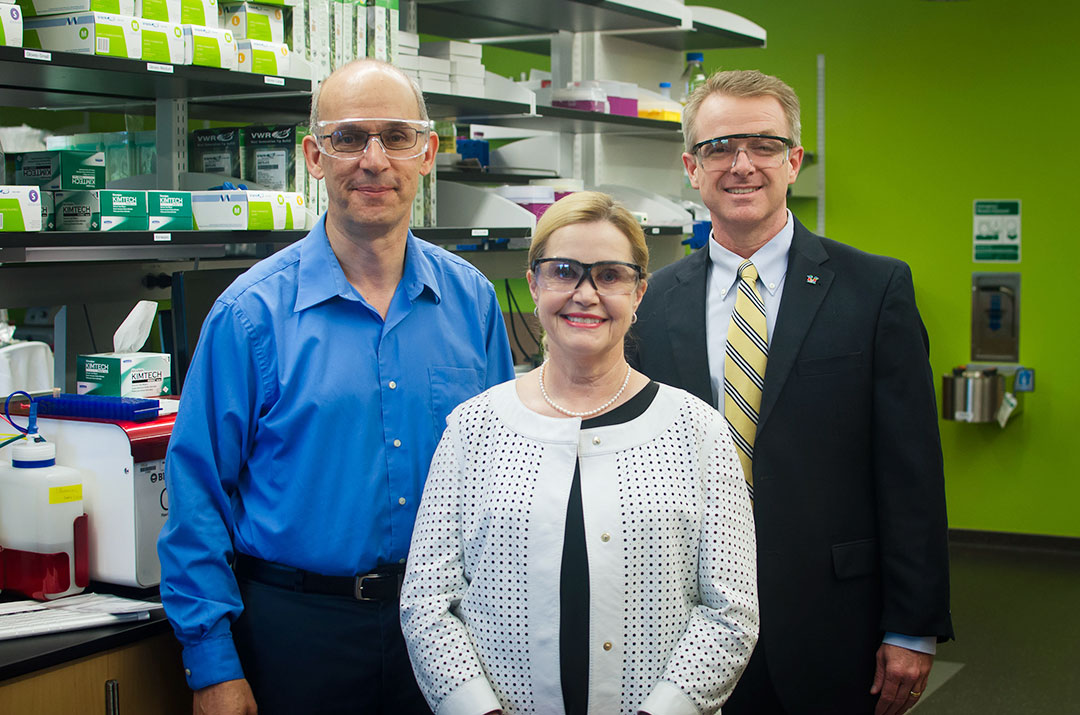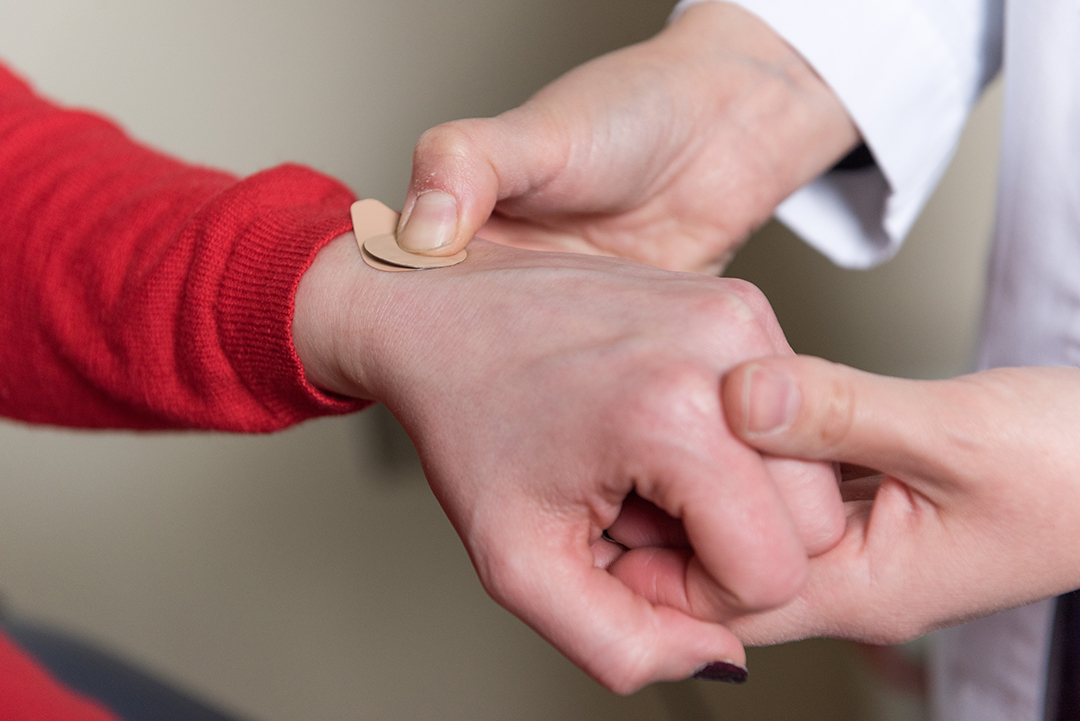
Annual Report 2017 Navigation
Changing Lives through Research
The Georgia Tech research enterprise dreams big — and puts those dreams into action by partnering with industry and government to create the next big life-altering breakthroughs.

Dana Randall and Srinivas Aluru, co-executive directors of the Institute for Data Engineering and Science.
Data Engineering and Science IRI Formed to Facilitate Key Partnerships
Georgia Tech advanced its efforts to tackle the challenges of big data by creating the Institute for Data Engineering and Science (IDEaS). The new Interdisciplinary Research Institute (IRI) unites researchers across Georgia Tech, fosters important partnerships with industry, and plays a key role in building the community of the recently announced Coda building in Technology Square.
IDEaS is jointly led by Co-Executive Directors Srinivas Aluru and Dana Randall, both professors in the College of Computing, and includes researchers and faculty who span all six colleges, creating critical interdisciplinary research opportunities and positioning Georgia Tech at the forefront of big data solutions.
“As Georgia Tech becomes more visible as a thought leader in data science and engineering, the big idea for IDEaS is to provide the coordination and expertise necessary to link researchers across the Institute, strengthening our position in big data,” said Steve Cross, executive vice president for Research. “Doing so better equips them to take on important and complex problems. It creates meaningful partnerships and accessible resources, and educates future data science leaders.”
IDEaS will facilitate new ventures and industrial collaboration between Technology Square’s recently announced Coda building research neighborhoods, providing a unique opportunity for academia to rub shoulders with industry, and be an asset to other premier education, research, and public-serving institutions in Georgia. It will also collaborate with several stakeholders in Georgia, including the Technology Association of Georgia and the Georgia Manufacturing Extension Partnership, and serve as an incubator for economic development opportunities.
3-D Printed Tensegrity Objects Capable of Dramatic Shape Change
A team of researchers from Georgia Tech has developed a way to use 3-D printers to create objects capable of expanding dramatically that could someday be used in applications ranging from space missions to biomedical devices.
$17 Million Grant to Help Establish Science of Cyber Attribution
Georgia Tech was awarded a $17.3 million cybersecurity research contract to help establish new science around the ability to quickly, objectively, and positively identify the virtual actors responsible for cyberattacks, a technique known as “attribution.”
While the tools and techniques to be developed during the four-and-a-half-year effort won’t point directly to the individuals responsible, the initiative will provide proof of involvement by specific groups, identifiable by their methods of attack, consistent errors, and other unique characteristics. Such attribution could support potential sanctions and policy decisions — and discourage attacks by providing transparency for activities that are normally hidden.
The research, sponsored by the U.S. Department of Defense, will be led by researchers at Georgia Tech in collaboration with other academic institutions and companies. The project is expected to create an attribution framework dubbed Rhamnousia — in Greek mythology, the goddess of Rhamnous and the spirit of divine retribution.
“We should know who our friends are and who our enemies are in the cyber domain,” said Manos Antonakakis, an assistant professor in the School of Electrical and Computer Engineering and the project’s principal investigator. “We owe it to the people of this country to objectively reason about the actors attacking systems, stealing intellectual property, and tampering with our data. We want to take away the potential deniability that these attack groups now have.”
Georgia Tech hosts a bipartisan panel on Cybersecurity
U.S. Rep. Tom Graves (R-Ga.) and U.S. Rep. Kyrsten Sinema (D-Ariz.) participated in a panel discussion about cyber self-defense held on Georgia Tech's campus.
Cyber Innovation and Training Center Is Launched
Governor Nathan Deal announced $50 million in funding to establish the Georgia Cyber Innovation and Training Center in Augusta. Georgia Tech is providing key support and resources for the center, a state-owned cyber range that brings together academia, private industry, and government to establish cybersecurity standards across state and local agencies to develop and practice protocols for responding to cyber threats.
“We should know who our friends are and who our enemies are in the cyber domain ... We want to take away the potential deniability that these attack groups now have.”
Manos Antonakakis
“Cybersecurity is especially important now that cybercrime is bigger than the global black market for marijuana, cocaine, and heroin combined,” said Deal. “The protection of Georgia’s citizens, businesses, and institutions in the digital realm is becoming significantly more necessary as cybercrime continues to grow. Building on our efforts to keep Georgia safe and maintain its status as the No. 1 state in which to do business, we are taking action to ensure that Georgia leads the way on cybersecurity.”
The Georgia Cyber Innovation and Training Center will advance the field of information security with research on vulnerability that will help ensure reliable and effective practices. The facility will be focused on training, education, research, and development and will act as an incubator hub for cybersecurity startup companies. This concept is designed to challenge professionals and systems in a safe and protected setting in preparation for cyber incidents.
Scheller Research Indicates That Sound in Ads Matters

Michael Lowe, assistant professor of marketing at Scheller College of Business, studied the relationship between acoustic pitch and perceptions of size in advertising.
Lower pitches in voices or music in advertisements lead consumers to infer a larger product size, according to a new study by researchers at Georgia Tech’s Scheller College of Business and Vanderbilt University.
While sound is a fundamental element of nearly all marketing communications, from commercials to spokespeople and sales associates, Michael Lowe, assistant professor of marketing at Scheller College of Business, and Kelly Haws, associate professor of marketing at Vanderbilt’s Owen Graduate School of Management, indicated that marketers don’t have a firm grasp on what it communicates to customers.
“Research to date suggests that managers too often select music and spokespeople by intuition, with limited understanding regarding how these elements might affect actual product perceptions,” Lowe and Haws wrote in their new paper for The Journal of Marketing Research. “Some degree of importance, then, should be given to understanding what is actually being communicated about the product at a sensory level.”
In their paper, titled “Sounds Big: The Effects of Acoustic Pitch on Product Perceptions,” the coauthors show in six different studies how the effects of acoustic pitch on consumer beliefs depend on “cross-modal correspondence,” defined as the compatibility of stimuli perceived by one sense, such as sound, with a sensory experience in another, like sight.
One study found that acoustic pitch differences in voice affects perceptions of size. Participants listened to a radio advertisement for a new sandwich at a fictitious sandwich chain where a spokesperson’s voice was digitally altered to be higher or lower. Participants who heard the ad featuring the lower-pitched voice believed the sandwich was significantly larger than those who heard the higher-pitched version.
The same trend was observed in a separate study that tested the pitch level of music. Participants viewed a TV advertisement, with voiceover removed, for a laptop computer and answered several questions about their perceptions. Those who viewed a version of the ad with lower-pitched music perceived the laptop to be larger than those who viewed the higher-pitched variety.
Hair Spacing Keeps Honeybees Clean During Pollination
A Georgia Tech study that looked at how honeybees do their job and manage to stay clean found that a honeybee can carry up to 30 percent of its body weight in pollen because of the strategic spacing of its nearly 3 million hairs. The hairs cover the insect’s eyes and entire body in various densities that allow efficient cleaning and transport. The research found that the gap between each eye hair is approximately the same size as a grain of dandelion pollen, which is typically collected by bees. This keeps the pollen suspended above the eye and allows the forelegs to comb through and collect the particles.
Imlay Foundation Gives $5 Million for Pediatric Therapies Research

From left, M.G. Finn, chief scientific officer of Georgia Tech's Pediatric Technology Center and chair of the School of Chemistry and Biochemistry; Mary Ellen Imlay, chair of the Imlay Foundation; and Dr. Patrick Frias, chief operating officer at Children's Healthcare of Atlanta, in a laboratory in the Krone Engineered Biosystems Building where research is conducted via the Children's-Georgia Tech partnership.
Children’s Healthcare of Atlanta and Georgia Tech received a $5 million grant from The Imlay Foundation for the development of pediatric therapies. The single largest grant made by The Imlay Foundation in its 25-year history, the commitment establishes The Imlay Innovation Fund at Children’s Healthcare to advance collaboration between Georgia Tech and Children’s pediatric innovation and discovery efforts.
The research partnership with Georgia Tech is called the Children’s Healthcare of Atlanta Pediatric Technology Center. The collaborative research fostered through this partnership brings together clinicians from Children’s, academic scientists from Emory University, and engineers from Georgia Tech to solve important problems in pediatrics and develop technological solutions for improving the health of children. With the formation of the Children’s Pediatric Technology Center, Children’s and Georgia Tech are providing extraordinary opportunities for interdisciplinary collaboration in pediatrics, creating breakthrough discoveries that often can only be found at the intersection of multiple disciplines.
“It is through generous philanthropy that we are able to foster these alliances that help enhance the lives of children,” said Donna Hyland, president and CEO of Children’s. “Mary Ellen Imlay and her late husband, John, have demonstrated their love and appreciation of Children’s and Georgia Tech in a myriad of ways over the years through their volunteerism, board leadership, and philanthropy. This grant furthers their deep commitment to Children’s and Georgia Tech.”
The grant will help fund two collaborative programs, including Quick Wins, a novel program that allows Children’s clinicians and clinical administrative leaders to bring problems that impact care delivery to the attention of scientists and engineers at Georgia Tech to help develop technology-based solutions to improve pediatric health care. The funds will also support a program to help bridge the gap following proof to concept, giving investigators the ability to collect data, complete further proof-of-concept studies, or produce prototypes for testing in order to advance a solution to the next stage of development.
Next: ![]() Driving Economic Growth
Driving Economic Growth
Annual Report 2017 Navigation
(text and background only visible when logged in)



